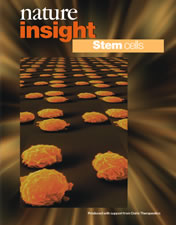Stem cells
Vol.
414, No. 6859 (1 November 2001).
|![]() PDF
PDF![]() (172
(172![]() K)
K)![]() |
|
 |
| Cover
illustration |
Stem cells are truly remarkable. They bridge the gulf between the fertilized egg that is our origin and the architecture that we become. They supply the cells that construct our adult bodies and, as we age, replenish worn out, damaged and diseased tissues. They renew themselves, resisting the powerful pull towards differentiation that overcomes more prosaic cells. And depending on the source, they have the potential to form one, many or all cell types of an organism.
Stem cell research has a history of more than 20 years, and has made some outstanding contributions to our understanding of haematopoiesis and mouse embryology. But the field has been transformed in the past few years by successes achieved in culturing human embryonic stem cells, the building blocks for every tissue we comprise, and in manipulating their differentiation in vitro. More recently, excitement has been fuelled by the controversial evidence that adult stem cells have a much higher degree of developmental potential than was previously imagined.
Scientists now face the formidable task of justifying all the attention by bringing stem cell therapies to the clinic. But this will demand a better understanding of stem cells at the molecular level and of how they behave in their biological context. The factors that maintain stem cells in a multipotent, proliferative state, or drive them to create differentiated daughter cells in vitro or in vivo, must be identified.
In commissioning this Insight, we have asked top researchers to cut through the hype and explain the fundamentals of stem cell biology as they see it today. We hope that scientists, clinicians and general readers alike will find these articles both enlightening and thought provoking.
Natalie DeWitt Senior Editor
| The
future for stem cell research ROBIN LOVELL-BADGE
| 88 | ||
| The
end of the beginning for pluripotent stem cells PETER J. DONOVAN AND JOHN GEARHART
| 92 | ||
| Stem
cells find their niche ALLAN SPRADLING, DANIELA DRUMMOND-BARBOSA & TOSHIE KAI
| 98 | ||
| Stem
cells, cancer, and cancer stem cells TANNISHTHA REYA, SEAN J. MORRISON, MICHAEL F. CLARKE & IRVING L. WEISSMAN
| 105 | ||
| The
development of neural stem cells SALLY TEMPLE
| 112 | ||
| Stem
cells in tissue engineering PAOLO BIANCO AND PAMELA GEHRON ROBEY
| 118 | ||
| Reprogramming
of genome function through epigenetic inheritance M. AZIM SURANI
| 122 | ||
| Ethical
and social considerations of stem cell research ANNE MCLAREN
| 129 | ||
| Leaders
in stem cell medicine Osiris Therapeutics
| 132 | ||
| When
the body can't heal itself Osiris Therapeutics
| |||